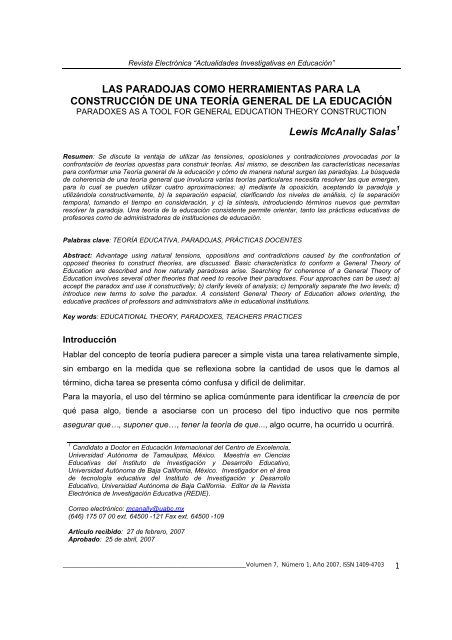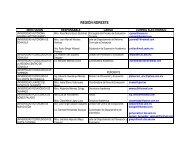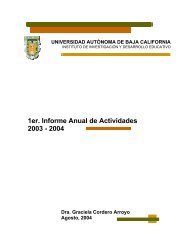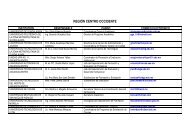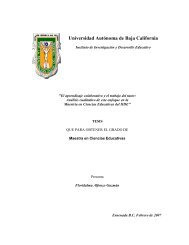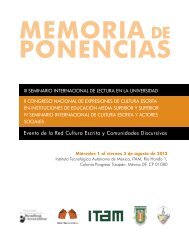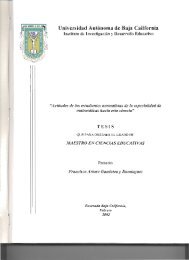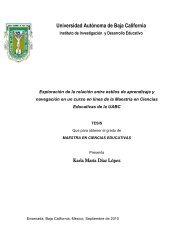LAS PARADOJAS COMO HERRAMIENTAS PARA LA ...
LAS PARADOJAS COMO HERRAMIENTAS PARA LA ...
LAS PARADOJAS COMO HERRAMIENTAS PARA LA ...
Create successful ePaper yourself
Turn your PDF publications into a flip-book with our unique Google optimized e-Paper software.
Revista Electrónica “Actualidades Investigativas en Educación”<br />
<strong><strong>LA</strong>S</strong> <strong><strong>PARA</strong>DOJAS</strong> <strong>COMO</strong> <strong>HERRAMIENTAS</strong> <strong>PARA</strong> <strong>LA</strong><br />
CONSTRUCCIÓN DE UNA TEORÍA GENERAL DE <strong>LA</strong> EDUCACIÓN<br />
<strong>PARA</strong>DOXES AS A TOOL FOR GENERAL EDUCATION THEORY CONSTRUCTION<br />
Lewis McAnally Salas 1<br />
Resumen: Se discute la ventaja de utilizar las tensiones, oposiciones y contradicciones provocadas por la<br />
confrontación de teorías opuestas para construir teorías. Así mismo, se describen las características necesarias<br />
para conformar una Teoría general de la educación y cómo de manera natural surgen las paradojas. La búsqueda<br />
de coherencia de una teoría general que involucra varias teorías particulares necesita resolver las que emergen,<br />
para lo cual se pueden utilizar cuatro aproximaciones: a) mediante la oposición, aceptando la paradoja y<br />
utilizándola constructivamente, b) la separación espacial, clarificando los niveles de análisis, c) la separación<br />
temporal, tomando el tiempo en consideración, y c) la síntesis, introduciendo términos nuevos que permitan<br />
resolver la paradoja. Una teoría de la educación consistente permite orientar, tanto las prácticas educativas de<br />
profesores como de administradores de instituciones de educación.<br />
Palabras clave: TEORÍA EDUCATIVA, <strong><strong>PARA</strong>DOJAS</strong>, PRÁCTICAS DOCENTES<br />
Abstract: Advantage using natural tensions, oppositions and contradictions caused by the confrontation of<br />
opposed theories to construct theories, are discussed. Basic characteristics to conform a General Theory of<br />
Education are described and how naturally paradoxes arise. Searching for coherence of a General Theory of<br />
Education involves several other theories that need to resolve their paradoxes. Four approaches can be used: a)<br />
accept the paradox and use it constructively; b) clarify levels of analysis; c) temporally separate the two levels; d)<br />
introduce new terms to solve the paradox. A consistent General Theory of Education allows orienting, the<br />
educative practices of professors and administrators alike in educational institutions.<br />
Key words: EDUCATIONAL THEORY, <strong>PARA</strong>DOXES, TEACHERS PRACTICES<br />
Introducción<br />
Hablar del concepto de teoría pudiera parecer a simple vista una tarea relativamente simple,<br />
sin embargo en la medida que se reflexiona sobre la cantidad de usos que le damos al<br />
término, dicha tarea se presenta cómo confusa y difícil de delimitar.<br />
Para la mayoría, el uso del término se aplica comúnmente para identificar la creencia de por<br />
qué pasa algo, tiende a asociarse con un proceso del tipo inductivo que nos permite<br />
asegurar que…, suponer que…, tener la teoría de que..., algo ocurre, ha ocurrido u ocurrirá.<br />
1 Candidato a Doctor en Educación Internacional del Centro de Excelencia,<br />
Universidad Autónoma de Tamaulipas, México. Maestría en Ciencias<br />
Educativas del Instituto de Investigación y Desarrollo Educativo,<br />
Universidad Autónoma de Baja California, México. Investigador en el área<br />
de tecnología educativa del Instituto de Investigación y Desarrollo<br />
Educativo, Universidad Autónoma de Baja California. Editor de la Revista<br />
Electrónica de Investigación Educativa (REDIE).<br />
Correo electrónico: mcanally@uabc.mx<br />
(646) 175 07 00 ext. 64500 -121 Fax ext. 64500 -109<br />
Artículo recibido: 27 de febrero, 2007<br />
Aprobado: 25 de abril, 2007<br />
______________________________________________________________Volumen 7, Número 1, Año 2007, ISSN 1409-4703<br />
1


